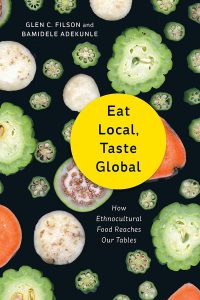Any book that examines the human condition through diet is welcome. Who is not wiser on learning Lester Pearson was so bland his favourite lunch was a poached egg, or that Britain’s Ministry of Food recommended rice soup as a wartime Christmas meal in 1917?
In Eat Local, Taste Global Professors Glen Filson and Bamidele Adekunle of the University of Guelph look at vegetables in documenting Canada’s demographic revolution. The nation has never seen so many different immigrants from so many varied lands – Asian, African, Caribbean, Middle Eastern. Authors note the nation imports 24.9 million pounds of okra annually, a third of it in the Toronto area through the largest vegetable wholesaler in the nation, the Ontario Food Terminal Board.
“While humans are often viewed as rational beings who make informed decisions to optimize their benefits, food decisions are not always rational,” says Eat Local. “This is evident as food serves many purposes beyond nutritional value, including construction of personal identity and pleasure.”
“There are many factors that influence food choice including previous exposure, expectations, economic factors, marketing, education and nutritional knowledge, social interactions, morality and religion, culture, lifestyle, age, food trends, media and the attributes of the individual,” authors explain.
Eat Local is a scholarly eye-opener for readers who recall when the range of exotic foreign foods in Canada ran a narrow gamut from chop suey to Japanese oranges. Today Canadians eat 21 million pounds’ worth of Asian purple eggplant every year, and 24 million pounds of yard-long beans. Foreign ingredients like cilantro, broccoli and artichokes, introduced by Italian immigrants, are commonplace. Bok choy and bitter melon are sold in most supermarkets in most medium-sized cities in Canada. Halal butchering has saved many a small, independent packing house.
Authors note this is simple economics – more immigrants, more income – but marvel that it occurs at all. Grocery retailing is heavily controlled among a handful of corporations, and inexpensive processed food is everywhere. “Our industrial diet has been and continues to be nutritionally degraded due to the ever-growing abundance of ‘pseudo-food’, an even broader category than the more widely used term ‘junk food’,” they write.
In 2013 the federal agency that regulates food safety, the Canadian Food Inspection Agency, even expanded the definition of “local” produce from a 50-kilometre radius to include interprovincial goods, meaning carrots sold as “local” in Vancouver may be trucked from Blairmore, Alta. “There is somewhat of a political economic tug-of-war between those controlling most of what we eat, and those wanting a more sustainable agriculture and local access to fresh, healthy food,” authors write. “This struggle occurs along the value chain from producers to processors, and distributors, wholesalers and retailers all the way to the consumers.”
By Holly Doan
Eat Local, Taste Global: How Ethnocultural Food Reaches Our Tables, by Glen Filson and Bamidele Adekunle; Wilfrid Laurier University Press; 200 pages; ISBN 9781-7711-23136; $27.99






